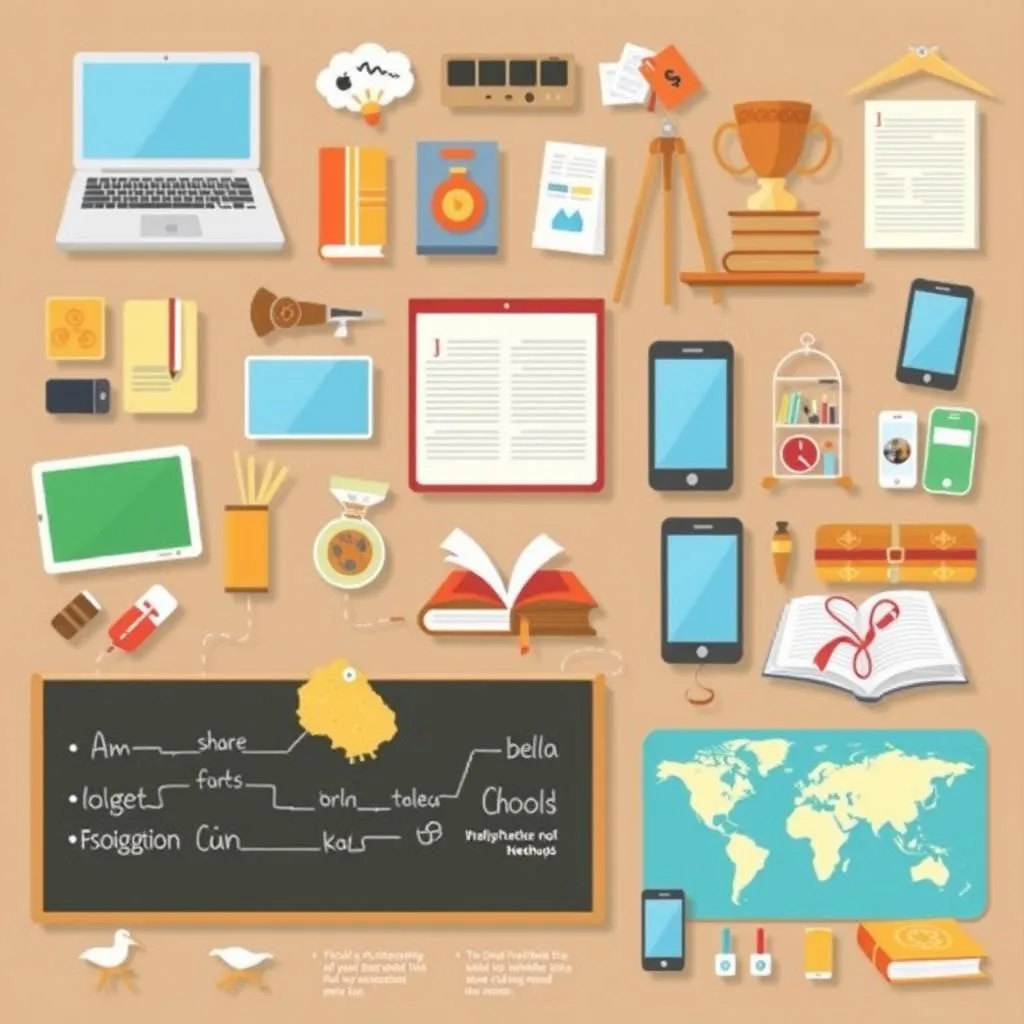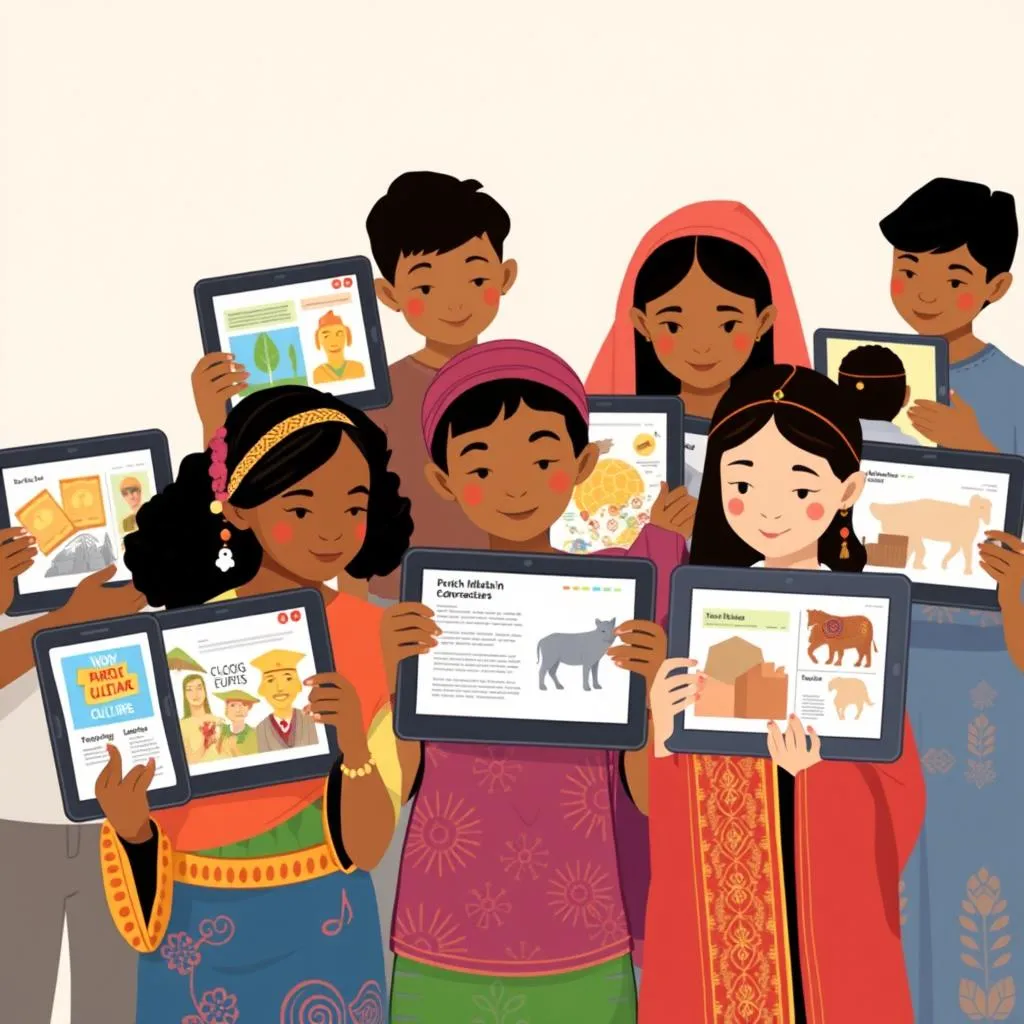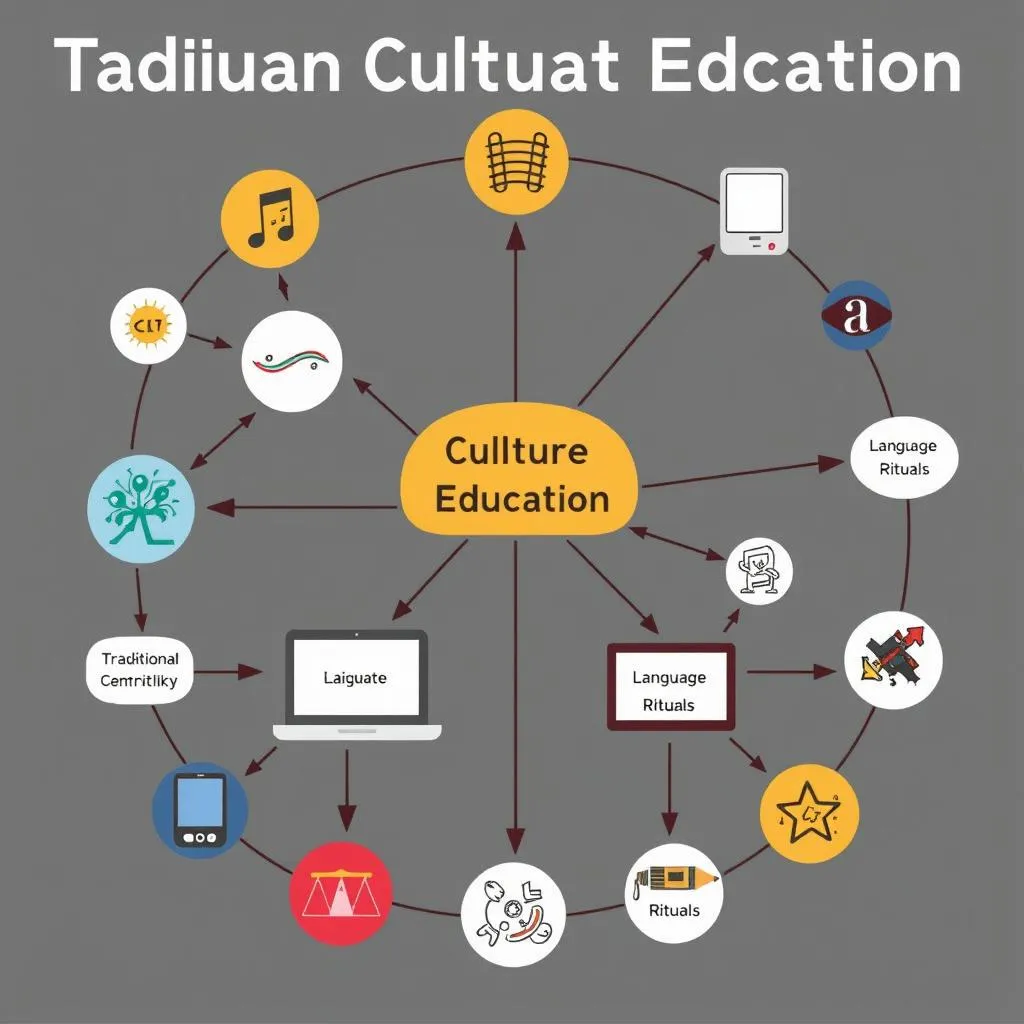The IELTS Reading section often features thought-provoking texts on contemporary issues, such as the impact of media on cultural traditions in education. This article provides a comprehensive practice test focusing on this topic, with three passages of increasing difficulty and a variety of question types to help you prepare for the real exam.
Cultural differences in parental involvement in education can significantly affect how media influences cultural traditions in the classroom. Let’s explore this theme through our practice test.
Passage 1 (Easy Text)
The Changing Face of Education
In recent years, the proliferation of digital media has had a profound impact on educational systems worldwide, reshaping cultural traditions and teaching methods. Traditional classroom settings are being augmented by online resources, creating a hybrid learning environment that blends old and new approaches. This shift has led to a recalibration of educational priorities, with many institutions now placing greater emphasis on digital literacy and technological proficiency.
The integration of media into education has brought both opportunities and challenges. On one hand, it has democratized access to information, allowing students from diverse backgrounds to engage with a wealth of resources previously unavailable to them. On the other hand, it has raised concerns about the preservation of cultural heritage and traditional knowledge transmission methods.
One significant change has been the role of teachers. No longer the sole source of information, educators now act more as facilitators, guiding students through the vast landscape of digital content. This shift has necessitated a reevaluation of teacher training programs, with a new focus on developing skills in digital pedagogy and online content curation.
 Media influence on education and cultural traditions
Media influence on education and cultural traditions
Parents, too, have seen their role evolve. With children increasingly exposed to global media influences, parents face the challenge of balancing cultural traditions with the demands of a digitally connected world. This has led to new forms of parental engagement in education, with many seeking ways to incorporate cultural values into their children’s digital learning experiences.
Questions 1-5
Do the following statements agree with the information given in the passage? Write
TRUE if the statement agrees with the information
FALSE if the statement contradicts the information
NOT GIVEN if there is no information on this
- Digital media has had no impact on traditional classroom settings.
- The integration of media in education has only brought opportunities, not challenges.
- Teachers now act more as facilitators than as the primary source of information.
- All parents have successfully balanced cultural traditions with digital learning.
- Digital literacy is now considered more important than traditional subjects in all schools.
Questions 6-10
Complete the sentences below. Choose NO MORE THAN TWO WORDS from the passage for each answer.
- The combination of traditional and modern teaching methods has created a __ learning environment.
- The integration of media into education has __ access to information for students from various backgrounds.
- There are concerns about how to __ cultural heritage in the face of digital transformation.
- Teacher training programs now focus on developing skills in digital pedagogy and __.
- Parents are seeking ways to incorporate __ into their children’s digital learning experiences.
Passage 2 (Medium Text)
Media’s Role in Shaping Cultural Perceptions in Education
The pervasive influence of media on education extends beyond the classroom, shaping cultural perceptions and influencing the way students understand their own heritage and that of others. This phenomenon has given rise to a complex interplay between globalization and localization in educational content, as institutions strive to maintain cultural relevance while preparing students for an interconnected world.
The impact of educational media on children’s cultural perceptions is particularly pronounced in the formative years. Educational programs and digital resources often present a curated view of different cultures, which can lead to both increased awareness and potential stereotyping. The challenge for educators lies in fostering critical thinking skills that allow students to navigate these representations and form nuanced understandings of cultural diversity.
In many countries, there has been a concerted effort to harness media for cultural preservation and promotion. Educational initiatives have emerged that use digital platforms to teach indigenous languages, traditional arts, and local histories. These projects aim to counterbalance the homogenizing effects of global media and ensure that local cultural knowledge is not lost in the digital age.
However, the integration of media in cultural education is not without controversy. Critics argue that the reductionist nature of digital representations can oversimplify complex cultural traditions, leading to a superficial understanding. There are concerns that the fast-paced, interactive nature of digital media may be at odds with traditional modes of cultural transmission that value patience, observation, and personal mentorship.
 Cultural education in the digital age
Cultural education in the digital age
The role of social media in shaping cultural perceptions among students has also come under scrutiny. While platforms like Instagram and TikTok offer unprecedented opportunities for cross-cultural exchange, they also raise questions about authenticity and the commodification of culture. Educators are grappling with how to teach students to engage critically with these platforms, distinguishing between genuine cultural insights and commercialized or appropriated content.
As education systems continue to evolve in response to technological advancements, the preservation of cultural traditions remains a key concern. The challenge lies in striking a balance between embracing the educational potential of new media and safeguarding the integrity of cultural heritage. This delicate equilibrium requires ongoing dialogue between educators, policymakers, cultural leaders, and technology experts to ensure that education in the digital age remains culturally rich and relevant.
Questions 11-14
Choose the correct letter, A, B, C, or D.
-
The passage suggests that the influence of media on education:
A) Is limited to classroom settings
B) Has no effect on cultural perceptions
C) Extends beyond the classroom and shapes cultural understanding
D) Only affects students in higher education -
Educational programs and digital resources often present:
A) An entirely accurate view of different cultures
B) A curated view of different cultures
C) Only negative stereotypes of cultures
D) Information about a single culture -
The use of digital platforms to teach indigenous languages and traditional arts aims to:
A) Replace traditional teaching methods
B) Counterbalance the homogenizing effects of global media
C) Eliminate the need for local cultural knowledge
D) Promote only Western cultural values -
Critics of media integration in cultural education argue that:
A) Digital representations can oversimplify complex cultural traditions
B) Digital media is too slow for effective learning
C) Traditional modes of cultural transmission are outdated
D) Personal mentorship is no longer necessary
Questions 15-19
Complete the summary below. Choose NO MORE THAN TWO WORDS from the passage for each answer.
The integration of media in education has created a complex relationship between (15) __ and localization in educational content. While media can increase cultural awareness, it also risks (16) __ . Educators face the challenge of developing students’ (17) __ skills to understand cultural diversity accurately. Some countries are using digital platforms to (18) __ and promote local cultures. However, there are concerns about the (19) __ nature of digital representations of culture.
Passage 3 (Hard Text)
The Dialectic of Media and Cultural Traditions in Educational Paradigms
The symbiosis between media and cultural traditions in contemporary education presents a multifaceted paradigm that challenges conventional pedagogical approaches. This relationship is characterized by a dynamic tension between the preservation of cultural heritage and the inexorable march of technological progress. As educational institutions grapple with this dichotomy, they must navigate a complex landscape where traditional values intersect with the imperatives of a globalized, media-saturated world.
The osmosis of media influences into cultural education has precipitated a reevaluation of curricular frameworks across diverse educational systems. This process of integration is not merely additive; rather, it engenders a fundamental transformation in the epistemological foundations of cultural transmission. The traditional unidirectional flow of cultural knowledge from elder to youth is being supplanted by a more dialogic model, where learners actively engage with and contribute to cultural narratives through digital platforms.
Cultural influences on the development of social-emotional learning are increasingly mediated through digital interfaces, presenting both opportunities and challenges for educators. The affective dimensions of cultural education, once primarily cultivated through direct interpersonal interactions, are now often experienced through the prism of social media and virtual communities. This shift necessitates a recalibration of pedagogical strategies to ensure that the nuanced, embodied aspects of cultural knowledge are not lost in the digital translation.
The commodification of cultural content in educational media raises pertinent questions about authenticity and representation. As cultural traditions are packaged and disseminated through digital channels, there is a risk of reductionism and decontextualization. Educators must therefore develop critical frameworks that enable students to discern between genuine cultural insights and simulacra that may perpetuate stereotypes or oversimplify complex cultural phenomena.
 Cultural education in the digital paradigm
Cultural education in the digital paradigm
The hegemony of Western media in global educational contexts presents a particular challenge to the preservation of diverse cultural traditions. The ubiquity of English-language content and Western cultural paradigms in digital educational resources can lead to a homogenization of cultural perspectives. Countering this trend requires proactive measures to promote linguistic and cultural diversity in digital educational content, ensuring that marginalized voices and subaltern narratives are adequately represented.
Cultural influences on student behavior in global classrooms are increasingly shaped by the media landscape, necessitating a reevaluation of classroom management strategies and intercultural competence frameworks. Educators must develop the capacity to mediate between diverse cultural expectations and the norms propagated through global media channels, fostering an environment of cultural pluralism and mutual respect.
The dialectic between media and cultural traditions in education is further complicated by the rapid evolution of technological platforms. The ephemeral nature of digital trends contrasts sharply with the longstanding nature of cultural traditions, creating a tension between immediacy and permanence. Educational institutions must therefore strike a delicate balance, leveraging the engaging qualities of new media while safeguarding the enduring value of cultural heritage.
As we navigate this complex terrain, it becomes evident that the future of cultural education lies not in a binary choice between tradition and innovation, but in a synthesis that honors the past while embracing the possibilities of the future. This integrative approach requires a fundamental rethinking of what constitutes cultural literacy in the digital age, encompassing both the ability to engage with traditional cultural forms and the capacity to critically navigate the media landscape that increasingly shapes our cultural perceptions.
How multiculturalism shapes modern education systems is inextricably linked to the media ecology in which these systems operate. The challenge for educators and policymakers is to craft pedagogical approaches that harness the connective power of media while preserving the depth and richness of cultural traditions. Only through such a nuanced and reflective approach can we hope to cultivate truly culturally literate global citizens equipped to thrive in an increasingly interconnected world.
Questions 20-24
Choose the correct letter, A, B, C, or D.
-
The relationship between media and cultural traditions in education is described as:
A) Straightforward and unproblematic
B) Characterized by dynamic tension
C) Entirely antagonistic
D) Irrelevant to modern pedagogy -
The traditional flow of cultural knowledge is being replaced by:
A) A unidirectional model from youth to elder
B) A complete rejection of cultural transmission
C) A more dialogic model with active learner engagement
D) An exclusively technology-based approach -
The commodification of cultural content in educational media raises concerns about:
A) The cost of digital resources
B) The lack of interest from students
C) Authenticity and representation
D) The speed of internet connections -
The ubiquity of English-language content and Western cultural paradigms in digital educational resources can lead to:
A) Improved global communication
B) A homogenization of cultural perspectives
C) The elimination of local languages
D) Increased cultural diversity -
The future of cultural education is suggested to lie in:
A) Completely abandoning traditional methods
B) Rejecting all forms of digital media
C) A synthesis of tradition and innovation
D) Focusing solely on technological skills
Questions 25-27
Complete the sentences below. Choose NO MORE THAN TWO WORDS from the passage for each answer.
- The affective dimensions of cultural education are now often experienced through the __ of social media and virtual communities.
- Educators must develop critical frameworks to help students distinguish between genuine cultural insights and __ that may perpetuate stereotypes.
- The __ nature of digital trends contrasts with the longstanding nature of cultural traditions.
Questions 28-30
Do the following statements agree with the claims of the writer? Write
YES if the statement agrees with the claims of the writer
NO if the statement contradicts the claims of the writer
NOT GIVEN if it is impossible to say what the writer thinks about this
- The integration of media in cultural education has only positive effects on preserving traditions.
- Educators need to develop strategies to mediate between diverse cultural expectations and media-propagated norms.
- The future of education lies in completely replacing traditional methods with digital approaches.
Answer Key
- FALSE
- FALSE
- TRUE
- NOT GIVEN
- NOT GIVEN
- hybrid
- democratized
- preservation
- online content curation
- cultural values
- C
- B
- B
- A
- globalization
- stereotyping
- critical thinking
- preserve
- reductionist
- B
- C
- C
- B
- C
- prism
- simulacra
- ephemeral
- NO
- YES
- NO
This comprehensive IELTS Reading practice test on “The Influence of Media on Cultural Traditions in Education” provides a robust examination of your reading comprehension skills. Remember to manage your time effectively, focusing on understanding the main ideas and supporting details in each passage. Practice regularly with similar texts to improve your speed and accuracy in the IELTS Reading section.


